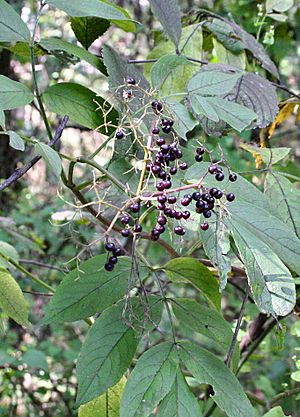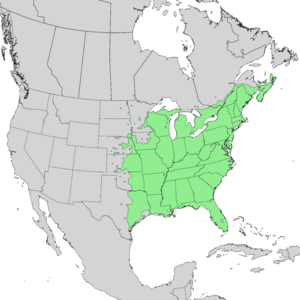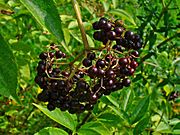American black elderberry facts for kids
Quick facts for kids American black elderberry |
|
|---|---|
 |
|
| Foliage and fruit | |
| Conservation status | |
| Scientific classification | |
| Genus: |
Sambucus
|
| Species: |
canadensis
|
 |
|
| Natural range of Sambucus canadensis in the United States and Canada | |
| Synonyms | |
|
Sambucus nigra subsp. canadensis (L.) Bolli |
|
Sambucus canadensis, also known as the American black elderberry or common elderberry, is a type of elderberry plant. It grows naturally across a large part of North America, especially east of the Rocky Mountains, and even as far south as Bolivia. You can find it in many different places, from wet to dry soils, but it loves sunny spots the most.
Contents
What Does it Look Like?
The American elderberry is a deciduous shrub, which means it loses its leaves in the fall. It can grow quite tall, up to about 20 feet (6 meters). This plant also spreads by sending out new shoots from its roots.
Its leaves grow in pairs opposite each other on the stem. Each leaf is made up of five to nine smaller leaflets. These leaflets are about 4 inches (10 cm) long and 2 inches (5 cm) wide.
In the summer, the plant produces large, flat clusters of white flowers. These clusters can be 8 to 12 inches (20–30 cm) across. Each tiny flower is about 0.2 inches (5–6 mm) wide and has five petals.
The fruit is called an elderberry. It is a dark purple to black berry that is about 0.1 to 0.2 inches (3–5 mm) wide. These berries grow in drooping clusters and ripen in the fall.
How is it Related to Other Plants?
The American elderberry is very similar to the European elderberry, called Sambucus nigra. Some scientists even think they are the same species, just different types. They sometimes call the American elderberry Sambucus nigra subspecies canadensis.
Is it Safe to Eat?
Some parts of the elderberry plant are not safe to eat, especially if they are raw. These include the leaves, stems, roots, seeds, and unripe fruits. They contain natural compounds that can be harmful if eaten in large amounts.
However, the ripe berries and the flowers are safe to eat. People often cook the ripe berries to make jams, jellies, and syrups. Cooking the berries and straining out the seeds helps make them safe to enjoy.
Research suggests that American elderberries have very low levels of these natural compounds. You would need to eat a very large amount of the unsafe parts (like several pounds of berries with seeds) to feel sick. So, it's always best to stick to the ripe, cooked berries and the flowers.
What is it Used For?
The elderflower (the flower of the plant) and the ripe berries are both edible.
- You can make a refreshing drink by soaking the flower heads in water.
- The ripe berries are used to make delicious wine, jelly, and even natural dyes.
- The leaves and the inner bark of the plant can be used as a natural insecticide (something that kills insects) and also as a dye.
- In traditional herbal medicine, the leaves have been used on the skin.
The name of the plant group, Sambucus, comes from an old Greek word. This word refers to an ancient wind instrument. People used to remove the soft center (pith) from the twigs of elderberry plants to make whistles.
The Iroquois people of North America traditionally used the boiled inner bark of the elderberry. They would apply it to the cheek to help with toothaches.
See also
 In Spanish: Sambucus canadensis para niños
In Spanish: Sambucus canadensis para niños





